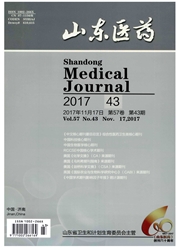

 中文摘要:
中文摘要:
目的观察热应激诱导雄性大鼠生殖功能的改变,并初步探讨其生理机制。方法清洁级Wistar大鼠64只,随机分成4组,即正常对照组及环境温度分别为38℃、40℃、42℃的3组热应激组,将大鼠暴露于高温环境lh/d,连续14d。分别于高温暴露后7d和14d进行大鼠性行为能力的观察,包括扑捉潜伏期(capture incubation period,CIP)、扑捉次数(capturetimes,CT)、精子相对计数、精子畸形率;血清与睾丸组织中超氧化物歧化酶(SOD)和丙二醛(MDA)等指标的检测。结果与正常对照组比较,42℃高温暴露7d,14d以及40℃高温暴露14d后大鼠的扑捉潜伏期显著延长,扑捉次数显著减少(P〈0.05);精子相对计数明显减少(P〈0.05);精子畸形率明显增加(P〈0.05);血清和睾丸组织中SOD的活性显著降低(P〈0.05),MDA的含量显著增加(P〈O.05);38℃热应激组上述各项指标与正常对照组相比均未见明显变化。结论高温环境暴露后,产生的热应激可改变雄性大鼠的生殖功能,其作用机制可能与生殖细胞的氧化损伤有关。
 英文摘要:
英文摘要:
Objective To investigate the heat-stress-induced male reproductive function changes in rats and exploreits mechanism. Methods Total of 64 male wistar rats with clean degree were randomly divided into the control group and the heat stress groups with 38℃, 40℃, 42℃. Heat exposure (1h/d) lasted for 14 d. Sex ability of rats was assessed including the capture incubation period (CIP) and the capture time (CT). After heat exposure, the number of sperm count and sperm deformity, the superoxide dismutase (SOD), and malondialdehyde (MDA) were detected. Reaulta Under 42℃ heat exposure, capture incubation period (CIP) of rat was prolonged and the capture time (CT) was reduced significantly (P〈0.05) on 7d, 14d and under 40℃ heat exposure on 14d. Under 42℃ heat exposure, relative sperm count and the activity of SOD in serum and testicular tissue were decreased significantly (P〈0.05), whereas sperm malformation rate and the content of MDA in serum and testicular tissue were increased significantly (P〈0.05) on 7d, 14d and under 40℃ heat exposure on 14d.. All the above-mentioned indexes had no significant changes compared with those of the control group. Conclusion Heat stress can affect male reproductive system, and its mechanism may be related to the oxidative damage of germ cells.
 同期刊论文项目
同期刊论文项目
 同项目期刊论文
同项目期刊论文
 期刊信息
期刊信息
